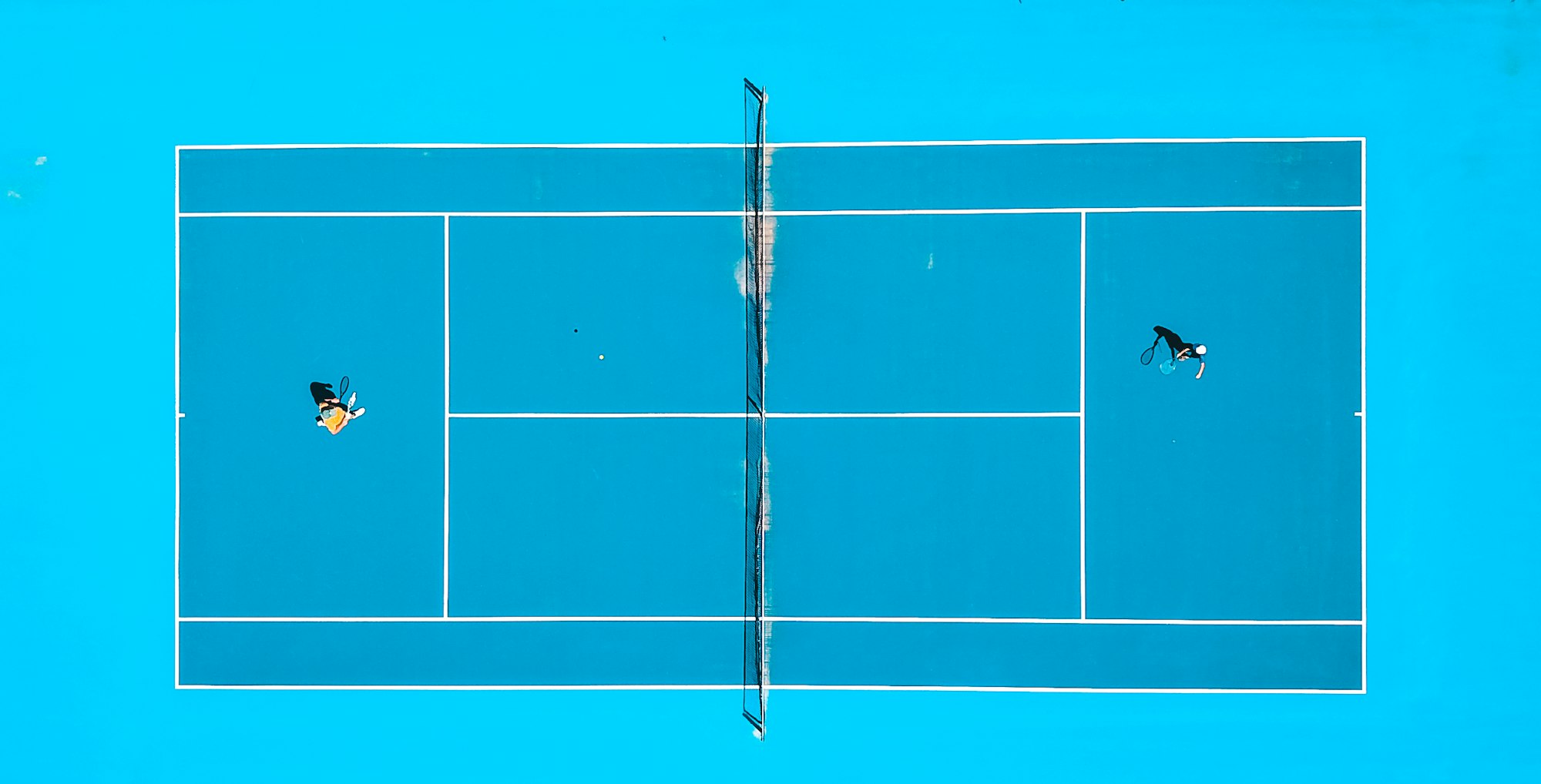Tennis is a sport that combines physical prowess with mental acuity, and understanding its scoring system is crucial for players and fans alike. In this article, we'll delve into the intricacies of what comprises a match in tennis, exploring the rules and structures that make this game so fascinating.
Key Takeaways:
- A tennis match is structured around a unique scoring system that includes games, sets, and the match itself.
- Tiebreaks and advantage sets are used to determine the winner in close sets.
- Grand Slam tournaments have specific rules for final sets, differing from regular professional tournaments.
The Basic Structure of Tennis Matches
Tennis matches are a test of endurance and skill, with players vying to outscore their opponents by winning enough games and sets. A standard match is often played as a best of three or best of five sets.
Each set is composed of games, and it takes at least six games to win a set, provided there is a two game lead. If the set reaches a 6-6 tie, a tiebreak game is usually played to decide the winner of the set.
Understanding the Tennis Scoring System
The tennis scoring system is unique and can be perplexing for newcomers. A game consists of points starting from love (zero), and players must win at least four points to win the game.
However, they must also have a two-point lead. If the score is tied at 40-40, known as deuce, the next point won is called the advantage point. If the same player wins the next point, they win the game; if not, the score returns to deuce.
The Role of Games in a Set
In tennis, how many games to win a set is not just a matter of reaching a certain number; it's about outplaying the opponent consistently.
A player or team must win at least six games and have at least a two-game lead over their opponent to clinch a set. If the players reach a 5-5 tie, the set continues until one player leads by two games, unless a tiebreak is played at 6-6.

The Intricacies of Winning a Set
Winning a set in tennis is a significant milestone towards winning the match. The set score reflects the number of games won by each player or team.
If a player reaches six games but the opponent has five, another game is played. If the leading player wins, they win the set 7-5; if not, the set may go to a tiebreak at 6-6.
The Decisive Tiebreak Game (seven points)
When a set is tied at 6-6, a tiebreak game is often the decider. In a tiebreak, players compete to be the first to reach seven points with a margin of at least two points.
The tiebreak adds a layer of pressure, as every point becomes crucial. The player who wins the tiebreak game wins the set 7-6.
The Final Set Dilemma: Advantage or Tiebreak?
In most professional tournaments, the final set does not end in a traditional tiebreak. Instead, players continue until one has a two game lead. However, this is not the case in all tournaments.
For instance, the US Open employs a tiebreak set in the final set, while the French Open uses an advantage set, requiring a two game lead with no tiebreak.
Grand Slam Matches: A Unique Challenge
The four grand slam tournaments – the Australian Open, French Open, Wimbledon, and US Open – each have their own rules for final sets.
Wimbledon and the Australian Open now use a special tiebreak at 12-12 in the final set, while the French Open requires players to continue until one has a two game lead. The US Open has used a standard tiebreak at 6-6 since 1970.

The Strategy Behind Choosing the Side of the Court
Have you ever wondered how players decide which side of the court to start on in a tennis match? It's not just a matter of preference; there's a strategic element involved.
Before the first game, a coin toss usually determines who gets the choice. The player who wins the toss can choose the side, opt to serve or receive, or even defer the decision to their opponent. Choosing the right side can be crucial, especially if the sun is a factor, or if one side has a prevailing wind.
Players often have a favorite side where they feel more comfortable or where their serve works best, and this can give them an edge in those crucial opening games played.
In doubles matches, the decision becomes even more strategic. In women's doubles matches, for instance, team dynamics play a significant role. If one player has a particularly strong ad-court game, the team might choose a side that allows them to capitalize on this strength from the very first point.
The side of the court can also affect how the ball bounces and spins, which can be used to the advantage of a team with a strong understanding of the tennis court's nuances.
Every game played is a step towards victory, and starting on the right foot—or side—can set the tone for the entire match.
The Significance of the Fifth Set in Men's Matches
The fifth set in men's matches, particularly at Grand Slams, is where legends are made and nerves are tested. Unlike women's matches, which typically are best of three sets, men's matches can extend to a grueling best of five.
This means that a player must win at least three sets to claim victory, and the fifth set often becomes the ultimate test of endurance and skill. It's not just about the physical toll; the mental fortitude required to stay focused and maintain a high level of play is immense.
The fifth set is where you'll see players digging deep, finding reserves of energy they didn't know they had, and where every single point can feel like a monumental struggle.
In some tournaments, the fifth set has its own unique rules. For instance, at Wimbledon, if the score reaches 12-12, a tiebreak is played to decide the winner. This adds an extra layer of suspense for both players and fans alike.
The player who manages to keep their cool and secure a two-point lead can walk away with the match, but getting there is no small feat. The game reaches deuce, and the crowd holds its breath, knowing that the next few rallies could change the course of tennis history.
The fifth set is not just another part of the match; it's the crescendo of a symphonic battle, the final act in an epic drama.

The Pivotal Moments in Women's Doubles Matches
Have you ever watched a women's doubles match and felt the palpable tension during those pivotal moments? It's not just about the one point that could change the momentum; it's about the synergy between partners.
In women's doubles matches, communication and coordination are key. Each player must be acutely aware of their partner's position and play style, making split-second decisions that can lead to a crucial break or a defensive save.
Unlike singles, doubles requires a ballet of movements and a deep understanding of shared strategy to capitalize on every point.
Now, consider the scenario where a team is just a two-point lead away from clinching the game. This is where mental toughness comes into play. In women's doubles matches, the pressure can be intense, as both players must maintain focus and avoid unforced errors.
A two-point lead might seem small, but in the fast-paced world of doubles, it can be a mountain to climb for the opponents.
The team with the lead must work in perfect harmony to convert those points into a game win, leveraging their combined strengths to outmaneuver the opposition.
The Significance of a Two-Point Lead in Men's Matches
In men's matches, a two-point lead can often be the razor-thin margin that decides the outcome of a game. It's a psychological advantage that can boost a player's confidence or, conversely, increase the pressure on the opponent.
When a player secures a two-point lead, it's a signal to the opponent that there's no room for error. This can lead to more conservative play from the trailing player, who may attempt to avoid mistakes rather than going for aggressive, high-risk shots.
The leader, on the other hand, can use this cushion to play more freely and put additional pressure on their opponent.
But let's not forget, in tennis, the tide can turn quickly. A two-point lead is significant, yet it's not insurmountable. Men's matches often showcase the fighter's spirit, where players dig deep to overcome deficits.
A player behind by two points may increase their level of aggression to disrupt the leader's rhythm. This is where we witness breathtaking comebacks and shifts in momentum that make tennis such an exhilarating sport to watch and play.
The battle for every point is a mental and physical chess match, with a two-point lead being a small but critical advantage in the quest for victory.

The Dynamics of Women's Doubles Matches
Women's doubles matches bring a unique flavor to the tennis world, showcasing teamwork and strategy that's different from the singles game. In these matches, communication is key, as each team works to outmaneuver their opponents with a combination of powerful serves, sharp volleys, and tactical placements.
A women's doubles team wins by understanding each other's strengths and covering the court effectively, ensuring that they can respond to whatever their opponents throw at them.
It's a dance of precision and power, with each player contributing to the collective goal of securing at least two games ahead of their adversaries to clinch the set.
When the game reaches deuce in a women's doubles match, the pressure intensifies. At this juncture, teams must exhibit exceptional focus to gain the crucial one-point advantage that could lead them to victory.
Unlike singles, where the spotlight is on one player, doubles requires a seamless partnership where both players must maintain a two-point lead to win the game. This can lead to nail-biting exchanges and breathtaking rallies, as the team that holds their nerve during these deuce points often gains the upper hand.
The synergy between partners, the split-second decisions, and the collective cheer when a team wins a hard-fought deuce point – all of these elements make women's doubles matches a thrilling spectacle for tennis enthusiasts.
The Unpredictability of the Third Set in Best of Three Matches
In best of three match formats, the third set often becomes the arena where champions are made. Unlike the first two sets, where players are still finding their rhythm, the third set is where fatigue and mental toughness come into play.
In men's matches, which typically are best of three outside of the Grand Slams, the third set is the decider, and the pressure is palpable. Each point wins not just the game but inches the player closer to overall victory.
If the match reaches six points all, a tie break is usually played to determine the winner, adding an extra layer of suspense.
For women's matches, which also follow the best of three sets format, the third set can be a test of endurance and strategy. Players must maintain at least a two-point lead to clinch the set, and this is where break points and deuce points become critical. A single break of serve can shift the momentum dramatically.
The third set is a battle of wills, where players must dig deep, often finding those extra three points to secure a five games to three lead, or pushing through a grueling tie break that demands a player to reach seven points with a two-point lead.
The third set is where tennis scoring work becomes a mental chess game, with each player looking to outmaneuver the other in a quest for victory.

The Dynamics of Doubles Matches
Doubles matches in tennis, including men's, women's, and mixed doubles, follow the same basic scoring rules as singles matches. However, the court is wider, and the team must work in unison to win points. In grand slam matches, men's doubles are typically best of five sets, while women's and mixed doubles are best of three.
The Peculiarities of Wheelchair Tennis
Wheelchair tennis follows the same scoring rules as able-bodied tennis, but with one key difference: the ball can bounce twice. This adaptation maintains the competitive nature of the sport while accommodating the players' mobility.
The Significance of the Serve
The serve is a fundamental aspect of tennis, initiating every point. A player has two chances to get the serve in play; failing both is a double fault, awarding the point to the opponent. The server aims to win points directly with an ace or set up the point to their advantage.
The Importance of Break Points
A break point in tennis is a game point for the receiver; if they win it, they 'break' the server's game. Breaking serve can shift the momentum of a match, as it's generally harder to win games as the receiver. Players often become more aggressive or strategic when facing or having a break point.
Dealing with Deuce
When the game score reaches deuce, the pressure mounts. Players must win two consecutive points from deuce to win the game. The first point after deuce is called the advantage point; if the player with the advantage wins the next point, they win the game, but if they lose, the score returns to deuce.
The Mental Game: Handling Pressure Points
Tennis is as much a mental game as it is physical. Players must maintain focus during crucial points, such as break points, set points, and match points. The ability to handle these pressure points often separates the great players from the rest.
The Longest Professional Tennis Match
The longest professional tennis match in history took place at Wimbledon in 2010 between John Isner and Nicolas Mahut, lasting 11 hours and 5 minutes over three days. The final set alone went to 70-68, showcasing the endurance required in grand slam matches without a final set tiebreak.
The Evolution of Tennis Scoring
The tennis scoring system has evolved from its origins in the French game of jeu de paume. The unique scoring system, with terms like love, deuce, and advantage, has historical roots and has remained a distinctive aspect of the sport.

Some Final Thoughts
Understanding what comprises a match in tennis is essential for appreciating the sport's complexity and drama. From the basic structure of games and sets to the unique scoring system and the variations in grand slam matches, tennis offers a blend of strategic depth and physical challenge.
Whether it's the tension of a tiebreak game or the endurance test of an advantage final set, tennis scoring rules create a captivating spectacle for players and fans alike.
FAQ's
How many sets do you need to win to win a tennis match?
Typically, men's matches in grand slams are best of five sets, while women's matches and most other professional tournaments are best of three sets. The player or team needs to win the majority of the sets (two out of three, or three out of five) to win the match.
What happens if the score in a set reaches 6-6?
If the score in a set reaches 6-6, a tiebreak game is usually played to determine the winner of the set. The player or team must win at least seven points with a two or more points lead to win the tiebreak and the set.
Are the rules for grand slam matches different from other tournaments?
Yes, grand slam tournaments can have different rules for the final set. For example, the Australian Open and Wimbledon employ a final set tiebreak at 12-12, while the French Open requires players to continue until one has a two game lead. The US Open uses a standard tiebreak at 6-6 in the final set.












Member discussion